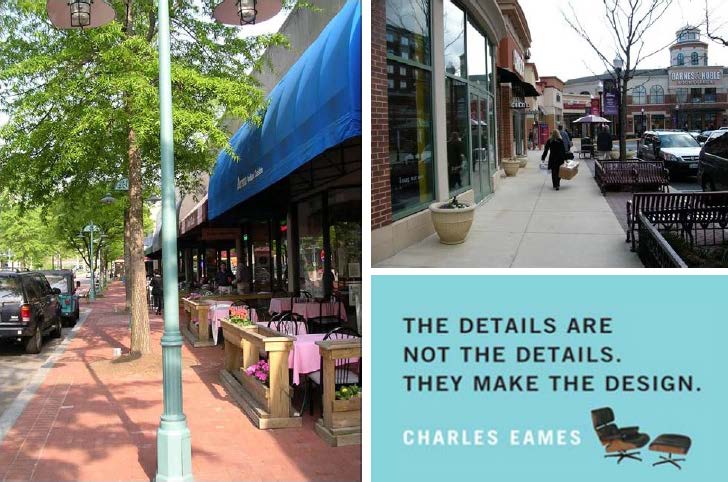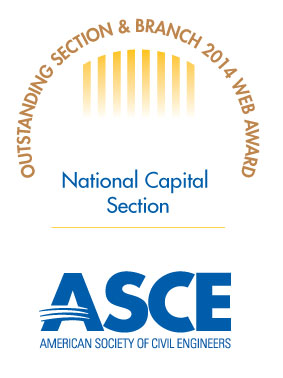For those of you who do not you spend your days making future plans for our streets, which I suspect is most you, our October 2014 Section Meeting guest, Ritch Viola, Supervisor of Arlington County’s Planning Section delivered insights that are sure to surprise and inspire you. Let me share with you some of these insights.
Boston was founded in 1630, Arlington in 1801. The 170-year difference between their founding continues to impact how these communities address the needs of those who walk to work or play to this day. Why? One of the first cars accessible to the masses was built by Ford in 1908. When infrastructure started in Boston, walking was a meaningful way to commute but when Arlington’s infrastructure started, cars were the mode of transportation. For Arlington to be recognized as a Gold Level walk friendly community by walkfriendly.org, the County had to contend with the infrastructure it had inherited more than one hundred years ago.

Consider the left photograph of the sidewalk. The light poles, trees, and storefronts were already in place when wide sidewalks were installed to accommodate heavier foot traffic; now they impede pedestrian traffic that must swing around the obstructions. When wide sidewalks are constructed around storefronts and integrated from the get go with a walk-friendly master plan, the light poles and trees are still installed, but away from foot traffic. Such details are planned.
As the major urban centers across our nation are growing in density, our reliance on modes of transportation other than cars is also growing. Rather than viewing cars as the primary customer of streets, the Complete Street initiative promotes the view that pedestrians, bicycles, buses, and transit should be treated as street customers on an equal footing with cars.
One approach to planning the future of streets is to rely on vehicle-mile-travelled projections that have not been reliable since the start of the twenty-first century. Another approach is to deliberately plot our future instead of looking to continue on a path predicted by extrapolation of the past. In other words, should our infrastructure be built on the idea that the future will continue to look like today but with a greater population density, or should we imagine and plan a future that addresses our transportation challenges in new and different ways that make the challenges irrelevant?
It was an absolute pleasure listening to Ritch and learning from his hard-won experience in helping make Arlington walk-friendly.
Arlington is one of only 14 communities in the USA that have been recognized as a Gold Level Walk-Friendly Community. Unlike most of the other top-rated communities, Arlington’s development has been relatively recent, mostly occurring in the mid- to 20th century, at a time when most American transportation networks have been automotive rather than pedestrian-oriented. Producing a highly pedestrian-friendly community in an age of automobiles requires a clear vision and strong determination to implement the policy and physical changes. The Arlington Master Transportation Plan (MTP) that was adopted between 2007 and 2012 provides the most recent expression of Arlington’s vision for its community. However the most important planning began decades prior and is manifested in the development of the many urban centers within most of Arlington’s recent growth has taken place and in the multi-modal transportation systems that support them. The changes to Arlington’s transportation plan began with key planning decisions that have been put into place through thousands of infrastructural improvements. Those improvements have included many street retrofit projects designed by the County’s engineering staff and through developer site plans guided by the staff and community advisory bodies. The development of design standards and guidance has been a continuous process as staff, consultants and other collaborators have learned from past efforts. This presentation will identify key aspects of what we have learned about how to make a community better for pedestrians. Mr. Ritch Viola is the Planning Section Supervisor for the Arlington County Division of Transportation. He began his career with the Arlington County government as the Bicycle Program Coordinator in 1987. His work for the County has included management of the bicycle and pedestrian programs, safe-to-routes-to-schools coordination, taxicab regulation and long-range transportation planning including project management for a complete revision of the County’s Master Transportation Plan. Ritch graduated from the University of North Carolina with a master’s degree in urban and regional planning and is a member of the American Institute of Certified Planners.
Mr. Richard Viola, Arlington County’s Transportation Planning Section Supervisor recounts lessons learned on making Arlington a vibrant urban city on October 21, 2014.


